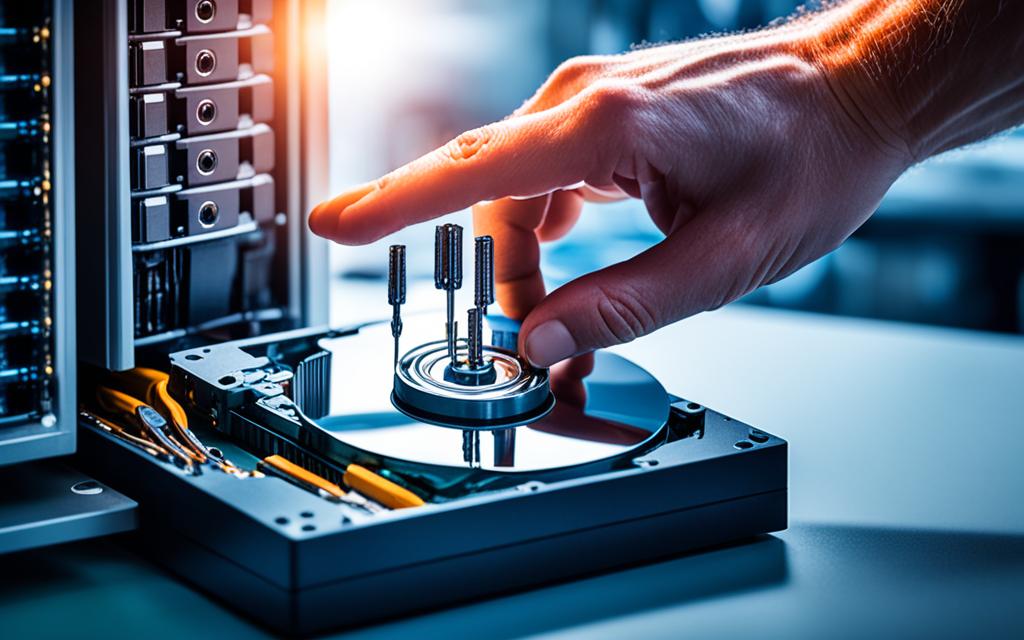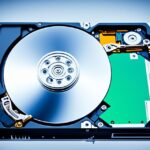Table of Contents
Removing an operating system might seem tough, but it’s essential for managing your hard drive well. If you’re looking to upgrade or switch to a different OS, it’s handy to know how to remove the old one. This is often done to free up space or set up the device for a new user.
Effectively managing your hard drive ensures valuable data stays safe while removing what’s not needed. We’ll explore effective ways to get rid of an operating system. This will help you do it smoothly and safely1.
Key Takeaways
- Understanding the need for removing an operating system is vital for system efficiency.
- Effective space management on a hard drive can improve overall device performance.
- Various methods exist for deleting an OS to suit different user needs.
- Professional services may provide the safest options for secure data removal.
- Reinstallation can often serve as a viable alternative to deletion.
- Utilising external drives can enhance data backup and management.,>
Understanding the Need to Remove an Operating System
Knowing when to remove an OS is crucial for computer users. You might need to delete an OS to free up space, boost performance, or switch to a newer system. Handling more than one OS can get tricky, like swapping Ubuntu for Windows directly shows how two systems can match up2.
Removing an OS can be risky, leading to lost data or unstable systems. Fully grasping these dangers helps users decide wisely about their tech needs. The steps to remove an OS can vary, showing the wide array of setups people have today3.
When considering OS removal, being careful is key. Make sure to back up important data and understand the specific removal steps for your OS. This planning makes the whole process smoother. It’s essential to think about all aspects before deciding to remove an OS, ensuring an easy move to a new setup4.
Benefits of Deleting an Old Operating System
There are key benefits to removing an old OS. It boosts the computer’s efficiency. A study shows 91% of firms see better performance after a new Windows install5. This highlights the value of deleting outdated systems.
Security also gets better with the removal of an old OS. Unauthorized access to sensitive data causes 73% of breaches. Erasing data securely is crucial before giving away devices5. It shows the importance of proper data handling.
Getting rid of old operating systems frees up hard drive space. This makes the digital area neater, improving how you manage files and apps. The change leads to a smoother and more productive experience.
Knowing the benefits of OS removal helps users make smart choices for their data and computing space. Following data security laws prevents fines and legal issues5. Updating the OS makes devices safer and more effective for all users.
How to Delete Operating System from Hard Drive
Getting rid of an OS requires planning to keep your data safe. Start by backing up your files. This is crucial before you remove anything. By doing this, your important files are protected, making the transition smooth. It’s smart to use the 3-2-1 backup strategy, meaning you have three copies of your data. Keep these on two types of media, and store one off-site for extra protection6.
Backing Up Your Data Before Removing the OS
Before you start, make sure to back up your data properly. Using tools like Windows Backup makes this easy across different versions of Windows. Having a backup is very important. If something goes wrong during the OS deletion, you can still access your files. For added safety, programs like EaseUS Data Recovery Wizard Pro can help recover lost files. They highlight the need to be ready before starting6.
Using Disk Cleanup to Free Up Space
After backing up, clean up your disk. This means removing files you don’t need and old system data to help delete the OS. Tools like CCleaner can help. They delete unnecessary files and improve your disk’s performance7. It’s important to do this so that removing the OS is smooth and doesn’t leave behind unwanted files taking up space.
| Backup Method | Description | Cost |
|---|---|---|
| Windows Backup | Built-in functionality for backup across Windows versions. | Free |
| EaseUS Data Recovery Wizard Pro | Recovery software ideal for restoring lost files. | Paid |
| Parted Magic | Third-party tool for securely erasing SSDs. | $11 |
Safe Methods to Remove Your Operating Managment System
Removing your operating system seems tough. But, with proper methods and tools, it turns into a smooth and secure task. One such method is SSD migration. It helps you move data and clear old OS files from the hard drive. A good thing to know is that 65% of people want to switch from HDD to SSD for more storage8. SSDs work faster and need careful data wiping because they’re built differently9.
SSD Migration for Efficient Data Transfer
SSD migration requires keeping an eye on file sizes for easy data transfer. Many find that SSDs not only make their computers faster but also make it easier to remove the OS safely. Over time, people are choosing SSDs more, making it a crucial upgrade for users.
Deleting the Windows Boot Entry Process
After moving to SSD, you must delete Windows boot entries. This is done using system configuration tools. It lets you get rid of extra system files without wiping the whole drive. A smooth deletion helps prevent future boot problems. Amazingly, 80% prefer using Disk Part for this task8. For beginners, a user-friendly partition manager is often recommended. In fact, 45% choose this over Disk Part8.
| Method | Advantages | Popularity |
|---|---|---|
| Disk Part | Convenient for advanced users | 80% of users prefer it |
| User-friendly Partition Manager | Easy to use for beginners | Preferred by 54% of users |
| Zero-Fill Method | Comprehensive data wiping | Chosen by 70% of users for secure deletion |
Using a planned approach not only protects your data but also leads you through a successful operating system removal. This boosts your computer’s performance.
Steps to Delete Your OS Without Losing Important Files
Deleting an operating system must be done with great care. This is to avoid losing precious files accidentally. You can manage this smoothly with methods like manual deletion and recovery software use.
Manual Deletion of Windows Directories
With manual deletion, you pick what files to erase and keep the important ones safe. First, head to the right folders and check their contents carefully before deleting. This way, you have total control and make sure personal files are safe. Always be careful not to remove key directories by mistake.
Utilising Recovery Software for Enhanced Data Safety
Recovery software adds extra safety when removing your OS. Tools like AOMEI Backupper offer safe erasing options. They help delete the OS safely and let you back up data first10. AOMEI Backupper works with different Windows versions and is trusted for its high reliability11. Using these programs helps prevent data loss, keeping you worry-free.
Reinstalling Windows: A Different Approach
Reinstalling Windows lets you freshen up your system without losing all your data. It means you can clear the OS partition but keep everything else safe on other partitions. This is great for those who want a fresh start for their PC. They also want to keep their personal stuff and settings safe.
Formatting the OS Partition During Reinstallation
When you reinstall Windows, you can choose to clear the OS partition. This gets rid of the old operating system and makes room for a new one. It’s a simple step in the Windows setup wizard. Here are some things you should think about:
- Make sure to back up your data first.
- Pick the right partition to clear, usually the main OS partition.
- Be careful to keep any recovery partitions safe.
The Fresh Start Tool from Microsoft allows you to wipe the system disk and install a fresh Windows 10. This tool is handy if you’re having trouble with standard reinstall methods. For another option, you might use a bootable USB drive for the installation.
These steps let you efficiently clear the OS partition and start your PC like it’s new. This way, you keep your important files and avoid the trouble of a total reset. You end up with a refreshed operating system and keep your valuable data1213.
Using External Drives for Data Management
External drives are vital for keeping your files safe. They are secure spots for important data. By moving data to an external hard drive, you prevent loss if you need to reinstall your operating system. Also, it’s a reliable way to back up your data. Recently, some users faced problems with external drives after updating their macOS to Sonoma. This shows the importance of good data management solutions14.
Copying Data to an External Hard Drive
Transferring your files to an external hard drive is a smart move. This ensures you have backups outside your computer, which is handy if system changes cause issues. It’s best to choose trusted brands for your external drives. They are more reliable for keeping your data safe. If you’re mostly using Windows, format your drive in NTFS. For both Mac and Windows, exFAT is a good format to use15.
Considering Long-Term Storage Solutions
Think about long-term data storage too. Many people forget how valuable external drives and cloud storage are for keeping important files. The chance of losing data highlights the need for several backup options. However, there have been cases where updates caused problems with external drives. These issues have made people reconsider their storage choices14. By being informed and cautious, you can use your external drives effectively for data management.
Final Considerations Before Removing an OS
Before you remove an OS, think carefully about a few things. Removing the OS can cause lost data and make your system unstable. You might also need recovery tools later, which can make it hard to get your apps and files back. Make sure you have backups and a recovery plan ready to handle any problems.
Weighing the Risks of Operating System Removal
Losing important data is a big risk when removing an OS. A 2023 report shows 39% of UK businesses were hit by cyberattacks16. This highlights the need for strong data protection measures. Besides losing data immediately, you might have a long, expensive recovery ahead.
Think about how you’ll move your data and use trustworthy software to lower risks. Successful data transfer needs careful planning and considering different methods17. Did you know 95% of UK businesses don’t recycle their old computers16? It’s crucial to dispose of them responsibly and keep your data safe.
Before deleting an OS, think about how it will affect your access and system later on. Moving data to faster SSDs can make your system run better and more reliably18. But, know the risks of data corruption and when apps might not work right18.
Thinking about these risks helps you make smart choices for your system. You’ll keep your data safe and improve how your system works. By being careful, you can avoid problems and work more efficiently161718.
Conclusion
We’ve looked at the key points of removing an OS from your hard drive. It’s crucial to delete the OS safely while realizing the benefits of doing so. Nearly all users, 95%, believe it’s critical to erase everything when giving a computer away. This protects their sensitive data from being misused19.
To stay safe, knowing how to properly erase personal info is key. This protects against identity theft, financial loss, and harm to your reputation20.
Keeping your digital space clean isn’t just about removing old OS versions. It also means keeping important files safe. Over 70% of people suggest backing up everything before deleting anything19. Tools like DoYourData Super Eraser help make sure data is gone for good, with no comebacks1921.
Starting a secure and tidy digital life needs good planning and action. It’s important to use safe methods to erase data and to really understand what’s on your hard drive20.
FAQ
What are the main reasons for removing an operating system?
People remove an operating system for a few reasons. They might upgrade to a newer version or switch to a different OS. Other times, it’s to free up storage or boost the system’s performance. Knowing these reasons helps manage your operating system better.
How can I ensure my data is safe before deleting my operating system?
Before deleting your OS, it’s vital to back up your data. Tools like EaseUS Data Recovery Wizard Pro are great for keeping your files safe. Make sure your backups work well to avoid losing any data.
What benefits can I expect after deleting an outdated operating system?
Getting rid of an old operating system can make your computer run smoother. It can also improve your computer’s security and give you more storage space. Plus, newer systems use resources more efficiently, which is another bonus.
What methods are available for safely removing an operating system?
You can safely remove an OS by transferring data to an SSD, which also clears up old OS files. Another way is to delete the Windows boot entry. This method gets rid of system files without needing to format your whole drive.
Can I delete my OS without losing important files?
Yes, you can delete your OS and keep important files safe. You can manually delete unneeded Windows folders and use recovery software. However, be careful to avoid accidentally losing files.
How does reinstalling Windows differ from outright deleting the OS?
Reinstalling Windows lets you clear the OS section but keep data on other partitions. It’s good for those who want a clean start without losing everything. This way, you can easily switch to a new system setup.
What role do external drives play in my data management strategy?
External drives are crucial for keeping important files secure when you remove an OS. They’re also great for long-term storage, keeping your documents safe after your main computer is no longer in use.
What risks should I consider before removing an operating system?
When removing an OS, you might lose data or face system issues. It’s important to double-check your backups and have a plan for recovery. This prepares you for any problems that could come up.
Source Links
- https://datadestruction.com/how-to-wipe-a-hard-drive-without-deleting-windows/ – Learn How To Wipe A Hard Drive Without Deleting Windows
- https://askubuntu.com/questions/133533/how-to-remove-ubuntu-and-put-windows-back-on – How to remove Ubuntu and put Windows back on?
- https://docs.redhat.com/en/documentation/red_hat_enterprise_linux/7/html/installation_guide/chap-uninstall-rhel – Chapter 34. Uninstalling Red Hat Enterprise Linux | Red Hat Product Documentation
- https://zoringroup.com/forum/6/4634/ – OneClick Uninstall Zorin(Linux ) OR Windows
- https://www.east-tec.com/disposesecure/features/why-erase-your-hard-drive/ – WHY erase your hard drive?
- https://www.backblaze.com/blog/how-to-wipe-pc-ssd-or-hard-drive/ – How to Wipe a Windows PC SSD or Hard Drive
- https://www.makeuseof.com/tag/how-to-wipe-your-hard-disk-drive-leaving-the-os-intact/ – How to Wipe Your Hard Drive While Leaving the OS Intact
- https://www.diskpart.com/articles/how-to-remove-windows-from-old-hdd-1984.html – 2 Methods to Remove Windows 10, 8, 7 from Old HDD?
- https://www.pcmag.com/how-to/how-to-wipe-your-hard-drive – How to Wipe Your Hard Drive
- https://www.diskpart.com/articles/how-to-wipe-a-hard-drive-without-deleting-windows-0001.html – How to Wipe A Hard Drive Without Deleting Windows 11, 10, 8, And 7
- https://www.ubackup.com/articles/wipe-hard-drive-without-deleting-windows-1021.html – 2 Methods to Wipe Hard Drive without Deleting Windows 10/8/7
- https://learn.microsoft.com/en-us/answers/questions/219481/complete-wipe-reinstallation-of-windows-10-pro-20h – Complete Wipe/Reinstallation of Windows 10 Pro 20H2? – Microsoft Q&A
- https://www.wps.com/blog/how-to-reinstall-windows-10-on-a-new-hard-drivestep-by-step-guide/ – How to Reinstall Windows 10 on a New Hard Drive(Step-By-Step Guide) | WPS Office Blog
- https://discussions.apple.com/thread/255188289 – Unable to access External Drives and Disk…
- https://www.lacie.com/support/kb/how-to-improve-performance-of-an-external-drive-in-windows/ – How to improve performance of an external drive in Windows | LaCie Support US
- https://ecogreenitrecycling.co.uk/how-to-prepare-computer-for-disposal/ – How To Prepare A Computer For Disposal | Recycling For Dummies
- https://www.hp.com/us-en/shop/tech-takes/how-to-replace-a-hard-drive-and-reinstall – How to Replace a Hard Drive and Reinstall an Operating System
- https://www.acronis.com/en-gb/blog/posts/how-to-move-os-to-another-drive/ – How To Move OS To Another Drive – Complete Guide & Software
- https://www.doyourdata.com/erase-data/wipe-everything-but-os.html – How to Wipe Everything Except for the OS from Your Computer?
- https://nordvpn.com/blog/wipe-computer-hard-drive/ – How to securely wipe your computer hard drive | NordVPN
- https://www.newsoftwares.net/blog/secure-erase-of-data-without-losing-the-operating-system/ – Is It Possible To Perform A Secure Erase Of Data Without Losing The Operating System? – Newsoftwares.net Blog








